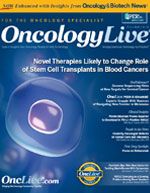Publication
Article
Oncology Live®
NSCLC Emerging as a Growing Problem Among Never-Smokers
Author(s):
A substantial—and potentially growing—proportion of patients with non–small cell lung cancer are people who never, or only rarely, smoked.
Lorraine Pelosof, MD, PhD
Assistant Professor, Internal Medicine
Harold C. Simmons Comprehensive Cancer Center
UT Southwestern Medical Center
Dallas, TX
Lung cancers account for more than one-quarter of cancer deaths in the United States, and the disease is expected to kill nearly160,000 Americans in 2016 alone. Early detection, which occurs in just 15% of cases, remains the best avenue to longterm survival; about half of patients found to have an early-stage lung cancer are alive 5 years after diagnosis, compared with fewer than 5% of patients whose cancers are detected after metastasis.1
The National Lung Screening Trial studied more than 53,000 patients and demonstrated that low-dose helical computed tomography (CT) is more effective at lung cancer early detection than standard chest X-rays, yielding—over an observation period of about 7 years—a 20% lower risk of dying from the disease.2 The trial enrolled only symptomless current or former smokers ages 55 to 74 who had a smoking history of 30 packyears (that is, a pack a day for 30 years, or 2 packs a day for 15 years) and who had been smokers within the prior 15 years.3
The success of the screening protocol is rooted in the fact that smoking is estimated to account for nearly 90% of lung, trachea, and bronchus cancers in men, and more than 70% in women.4 However, a substantial—and potentially growing—proportion of patients with non— small cell lung cancer (NSCLC) are people who never, or only rarely, smoked.
Newly described research, conducted by investigators at UT Southwestern and Simmons Comprehensive Cancer Center in Dallas, Parkland Hospital in Dallas, and Vanderbilt-Ingram Cancer Center in Nashville, reports an upward trend in the proportion of patients with NSCLC classified as never-smokers. The retrospective study examined data on more than 12,000 patients in 3 lung cancer registries, covering a period from 1990 to 2013.
The study found:
- The proportion of patients with NSCLC categorized as never-smokers grew not just at the university hospitals in the study (UT Southwestern and Vanderbilt) but also at Parkland, Dallas County’s public hospital
- Overall, 9% of patients with NSCLC were never- smokers in 1990-95, compared with 15% in 2011-2013
- Never-smokers with NSCLC were more likely to be women and, on average, were several years younger than patients who smoked
- The proportion of never-smokers among patients with small-cell lung cancer, did not significantly change5
From a research perspective, the study—and others with similar findings—highlights a need to investigate possible explanations for the development of NSCLC in patients who are never-smokers. A better understanding of lung cancer in never-smokers could, for example, advance efforts to identify possible underlying environmental causes (a list that currently includes radon, heavy metals, and secondhand smoke).
Growth in the never-smoker NSCLC population could also provide added impetus for the development of cheaper, noninvasive screening and diagnostic methods, such as blood- or sputum-based biomarkers, that would be practical for use in patient populations that appear to be only at medium or low risk of the disease. In the meantime, it is essential that clinicians understand that people with a history of never or rarely smoking are nevertheless at risk for lung cancer, and that this rate may be increasing.
Table. Percentage of Never-Smokers With NSCLC on Rise5
This table shows the percentage of never-smokers with non—small cell lung cancer (NSCLC) and small cell lung cancer (SCLC) as a proportion of all patients with lung cancer treated at UT Southwestern (UTSW) in Dallas, Parkland Hospital in Dallas, and Vanderbilt-Ingram Cancer Center in Nashville.
A history of lung cancer in the family could also be telling. At UT Southwestern, one patient with lung cancer with a scant smoking history—a 29-year-old woman who mentioned she had nonsmoking relatives who had died of the disease—led investigators to discover an inherited mutation that dramatically raises the risk of developing lung cancer, especially for women who don’t smoke.6 The rare anomaly is a germline T790M mutation of the EGFR gene; such a mutation more typically arises as resistance develops in the tumors of patients treated with EGFR tyrosine kinase inhibitors. Several of the women’s relatives were found to also have the mutation and were placed on a program of regular low-dose CT screening for lung cancer.
Because medical science has not identified any evidence-based means to effectively screen for lung cancer in broad populations of never-smokers physicians’ vigilance is the first line of defense. Until much more is known about NSCLC in never-smokers, a heightened awareness among healthcare providers offers the best chance of catching the disease earlier in these “atypical” patients.
References
- American Cancer Society. Cancer Facts & Figures 2015. Atlanta, GA: American Cancer Society, 2015. http://www.cancer.org/research/ cancerfactsstatistics/cancerfactsfigures2015/index.
- National Lung Screening Trial Research Team, Aberle DR, Adams AM, Berg CD, et al. Reduced lung-cancer mortality with low-dose computed tomographic screening. N Engl J Med. 2011;365(5):395-409.
- National Lung Screening Trial Research Team, Aberle DR, Berg CD, Black WC, et al. The National Lung Screening Trial: overview and study design. Radiology. 2011;258(1):243-253.
- US Department of Health and Human Services. The Health Consequences of Smoking: A Report of the U.S. Surgeon General 2004.
- Pelosof L, Ahn C, Horn L, et al. Increasing incidence of never smokers in non small cell lung cancer (NSCLC) patients. Presented at: International Association of the Study of Lung Cancer, 16th World Conference on Lung Cancer; September 6-9, 2015; Denver, CO. ORAL22.01.
- Gazdar A, Robinson L, Oliver D, et al. Hereditary lung cancer syndrome targets never smokers with germline EGFR gene T790M mutations. J Thorac Oncol. 2014;9(4):456-463.









